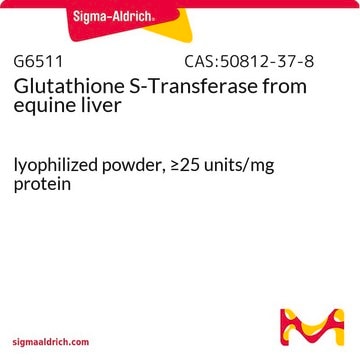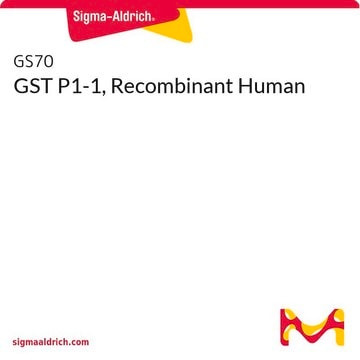G5663
Glutathione S-Transferase from E. coli
recombinant, expressed in E. coli, buffered aqueous solution
Sinónimos:
Glutathione S-alkenetransferase, Glutathione S-alkyltransferase, Glutathione S-aralkyltransferase, Glutathione S-aryltransferase, Glutathione S-epoxidetransferase, RX: Glutathione R-transferase
About This Item
Productos recomendados
recombinant
expressed in E. coli
grade
for molecular biology
form
buffered aqueous solution
mol wt
26 kDa
concentration
>0.1 mg/mL
>1 unit/mL
UniProt accession no.
shipped in
wet ice
storage temp.
2-8°C
Gene Information
human ... GSTM1(2944)
General description
Specificity
second substrate.
In ELISA, 0.5 μg of recombinant glutathione S-transferase is the minimum detectable level of enzyme with an anti-glutatione S-transferase, alkaline phosphatase conjugate.
In immunoblot, 50 ng of recombinant GST is the minimum detectable level of enzyme with an anti-glutathione S-transferase, alkaline phosphatase conjugate.
Application
Biochem/physiol Actions
Warning
Unit Definition
Physical form
Related product
Storage Class
12 - Non Combustible Liquids
wgk_germany
nwg
flash_point_f
Not applicable
flash_point_c
Not applicable
Certificados de análisis (COA)
Busque Certificados de análisis (COA) introduciendo el número de lote del producto. Los números de lote se encuentran en la etiqueta del producto después de las palabras «Lot» o «Batch»
¿Ya tiene este producto?
Encuentre la documentación para los productos que ha comprado recientemente en la Biblioteca de documentos.
Los clientes también vieron
Nuestro equipo de científicos tiene experiencia en todas las áreas de investigación: Ciencias de la vida, Ciencia de los materiales, Síntesis química, Cromatografía, Analítica y muchas otras.
Póngase en contacto con el Servicio técnico






